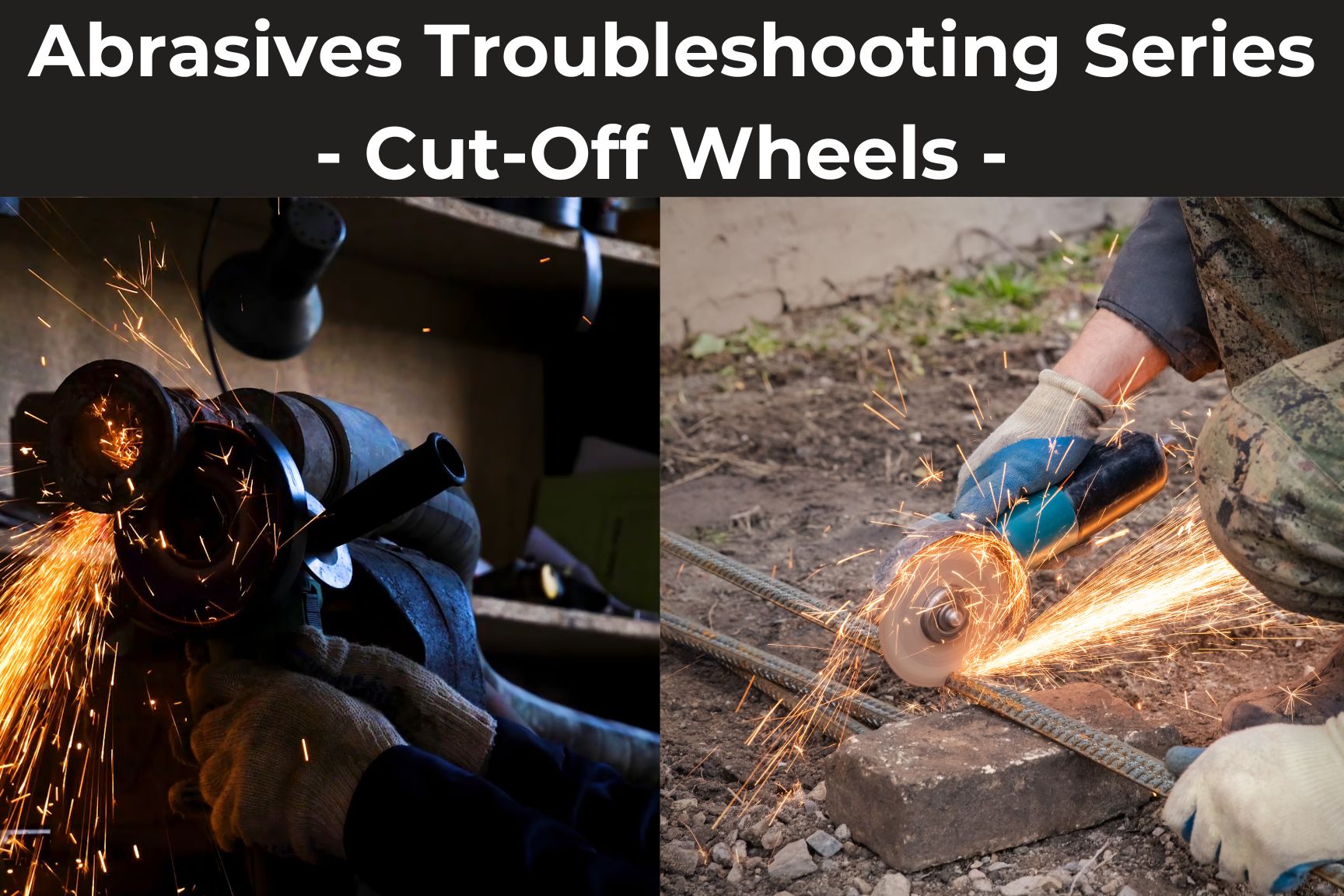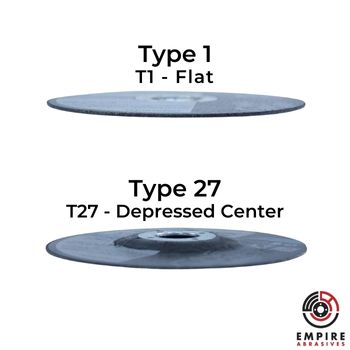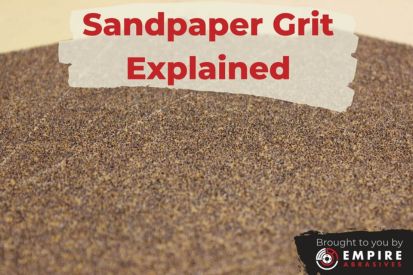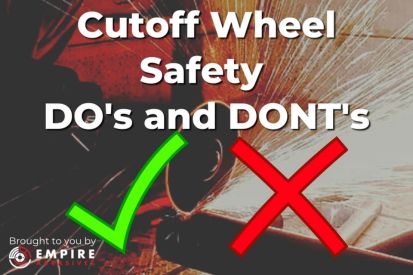
In this post, we’ll discuss common cut-off wheels issues. From their causes to cut-off wheel troubleshooting tips and solutions, we’ll arm you with all the information you need to maintain your cut-off wheels for the best finished product.
This post is a part of our blog series Troubleshooting Common Abrasive Tool Issues. You might also be interested in checking out:
Troubleshooting Common Abrasive Tool Issues - Sanding Belts
Troubleshooting Common Abrasive Tool Issues - Grinding Wheels for Angle Grinders
Troubleshooting Common Abrasive Tool Issues - Wire Brushes
Troubleshooting Common Abrasive Tool Issues - Tungsten Carbide Burrs
Troubleshooting Common Abrasive Tool Issues - Flap Discs
About Cut-Off Wheels
You may also see cut-off wheels labeled as cutting wheels or cut-off discs. This abrasive tool is a bonded abrasive wheel made with abrasive grain, most commonly aluminum oxide and/or silicon carbide, bonded to the wheel by a bonding agent such as resinoid.
Cut-off wheels are a powerful abrasive used for quick-cutting hard materials such as stone, concrete, ceramic tile, and metal. Typical uses include cutting pipe, metal fabrication, weld prep, and auto-body work.
Because of their relative lightness, and size, cut-off wheels are highly portable and commonly used with hand-held tools. Some places you may see or use a cut-off wheel include chop saws (used with larger chop saw wheels), circular saws, angle grinders, air cut-off tools, electric cut-off tools, and die grinders.
Common Cut-Off Wheels Issues
- Wheel breakage
- Uneven wear
- Premature wear
- Poor cutting performance
Causes and Troubleshooting
Here are some of the causes of the most common cut-off wheel issues and what you can do to prevent them from happening.
Proper Wheel Selection
Proper wheel selection is critical when it comes to extending the life of your cut-off wheel and power tools. It is also the first place to start when cut-off wheel troubleshooting.
Unfortunately, it is also one of the most common elements for people to get wrong. Depending on the thickness and type of material you are cutting, whether it is metal, ceramic, or aluminum, your cutting wheel needs are going to be different.
It’s not a one-size-fits-all situation.
How to Select the Proper Wheel for the Job
There are several aspects of a cut-off wheel to keep in mind. To choose the right one for the job, first, determine the type of work you’ll need the cutting wheel to perform and the material you’ll be working with. Once you know those, here are some tips on cut-off wheel options.
 Type
Type
Type 1 (T1) cut-off wheels are flat, provide maximum cutting surface, and are usually the best choice for general cutting. Its flatness enables it to create deep 90-degree angles. Type 1 cut-off wheels are commonly used in chop saws, high-speed saws, grinders, die grinders, and stationary saws.
Type 27 (T27) cut-off wheels feature a depressed center which allows for clearance and space when you are working at constrained angles. The depressed center also gives you a better view of your cuts. Type 27 cut-off wheels are specially designed to be used with right-angle grinders.
Size
Cutting wheels are available in a range of diameters. To ensure you have the correct size, remember that the RPMs or Revolutions per Minute labeled on the wheel needs to match or exceed the RPM rating of the tool using it. Typically:
- 2” to 4” are for die grinders
- 4” to 9” are for angle grinders
- 12” to 14” are for chop saws, stationary saws, and high-speed saws
Empire Abrasives carries a full line of cut-off wheel sizes:
- 2" Cut Off Wheels
- 3" Cut Off Wheels
- 4" Cut Off Wheels
- 4.5" Cut Off Wheels
- 5" Cut Off Wheels
- 6" Cut Off Wheels
- 7" Cut Off Wheels
- 9" Cut Off Wheels
- 12" Cut Off Wheels/Chop Saw Wheels
- 14" Cut Off Wheels/Chop Saw Wheels
Thickness
The thickness of the cut-off wheel you’ll need depends on the precision and accuracy you require.
Thin cut-off wheels are better for precise cuts. They also cut more quickly and generate less heat than thicker wheels. They remove less material with each cut, which is often advantageous.
However, thin wheels tend to wear out more quickly than thicker wheels, and if you are using a wheel that’s too thin for the job, you may end up using too much pressure for the wheel, risking excessive wear, instability, and failure.
Grain
Grain refers to the abrasive particles in the cut-off wheel that perform the cutting. There are several common types of grain used in cut-off wheels, including:
- Ceramic alumina - is suitable for steel, stainless steel, and other hard-to-cut metals.
- Zirconia alumina - used for steel, iron, and applications like rail cutting. They provide a fast cut and are long-lasting.
- Aluminum oxide - gives a fast cut and consistent performance.
- Silicon carbide - This grain is extremely hard for fast cutting, although it isn’t as tough as some other grains.
Like sandpaper or grinder belts, a cut-off wheel’s grain refers to the size of the particles. The smaller the grit size number, the larger or coarser the particle.
For more information - Sandpaper Grit Explained
Correct Mounting and Alignment
Correct mounting and alignment of cut-off wheels will help to ensure your safety, the longevity of the wheel, the machine, and the quality of work the wheel is able to perform.
Incorrect mounting and alignment can cause problems such as uneven wear and poor cutting performance.
Correct Mounting and Aligning Tips
- Always read and follow any instructions, guidelines, and cautions included with the cutting wheel.
- Check the cut-off wheel manufacturer’s website for additional brand-specific advice and warnings.
- Before mounting, ensure the machine has no power by unplugging or removing its batteries.
- Always mount and align according to the machine’s instructions and guidelines.
- Check and take care of damaged flanges before mounting.
- Take care to ensure the wheel is not too loose or too tight. Not only is this a sign of improper mounting, but it can lead to incorrect alignment and issues with precision and accuracy.
- Always properly install the guard making sure it is properly and safely between you and the wheel.
Proper Operating Speed and Pressure
Proper operating speed and pressure will ensure you are not working the cut-off wheel and machine harder than they’re meant to be. Incorrect rate and pressure can lead to safety issues, lack of control, lack of longevity, and lack of performance.
How to Ensure Proper Operating Speed and Pressure
First, always check the maximum operating speed on the wheel and make sure it matches with the machine’s operating speed.
When cutting, feed the wheel into the workpiece at a measured and consistent rate. Do not use excessive pressure, the spinning disc will do the work for you.
The key to using the correct pressure is to remember not to use too much or too little pressure. Don’t force the wheel. Allow it to do the work. Pushing too hard may cause the machine to stall or kick back.
Correct Cutting Technique
Using the correct cutting technique with your machine and cut-off wheel is crucial for work performance, safety, and longevity of your tools and cut-off wheels. Incorrect technique can impact everything, while correct cutting technique will give you the result you’re looking for.
Correct Cutting Technique Tips
- Read all safety materials specific to the machine and the cut-off wheels before operation.
- Make sure the workpiece is clamped correctly and secured at both ends.
- Always keep the cutting wheel at a 90-degree angle to the workpiece.
- Stop cutting if you hear any unusual sounds or feel any unusual vibrations. Stop if anything feels different than usual or even off in a way you can’t place. Inspect the wheel for damage or incorrect mounting. When in doubt, replace it.
- Feed the workpiece to the wheel at a consistent, controlled pace.
- Keep all clothing, body parts, or anything attached to your body clear of the cutting wheel.
- Never let the wheel bend, twist, or shift while cutting.
Regular Inspection and Maintenance
Regular inspection and maintenance are absolutely critical for safety and performance. This means you should inspect your wheels and machine every time before using them.
If you have not used a wheel or tool for a while, set yourself a reminder to inspect them and perform any maintenance you need to keep them working correctly.
Regular Inspection and Maintenance Tips
Make sure you take the following steps.
- Do a safety check before using any cut-off wheel. Check for damages and cracks to prevent breakage while in operation.
- Never use a wheel that is damaged, cracked, dropped, or struck with force.
- Do not use wheels that are bent, twisted, or warped in any way.
- Check the expiration date of your wheels. Environmental factors such as light, heat, and humidity can cause the bonding agents in the wheel to break down. Never use a cut-off wheel after its expiration date.
- Run the wheel for 60 seconds before cutting. This will allow you to spot any problems with the wheel or machine before risking your workpiece or safety.
Wear Proper Safety Gear
The importance of correctly wearing proper safety gear while working with cut-off wheels cannot be overstated.
Proper safety gear such as goggles, face shields, hearing protection, and respiratory protection keep you safe while working.
Safety gear ensures your safety while working with your tools. It also helps prevent issues from developing later due to prolonged exposure to irritants, inhaled particles, and excessive noise.
However, the importance of proper safety gear goes even further than your own protection. Wearing gear like goggles, face shields, and respiratory protection lets you see what you are doing and focus on the task, which can keep you from cut-off wheel troubleshooting, by spotting problems before they happen.
Again, this is a huge safety concern. However, it’s also a matter of being able to notice if there is an issue with your cutting wheel. The more protected you are, the more observant you can be and the more able you’ll be to stop an issue before it becomes a significant problem.
More info - Portable Cutoff Wheel Safety - Do’s, Don’ts, and Safe Practices
Conclusion
Now that you are armed with some knowledge about cut-off wheels and their common issues, it’s time to put this into practice. Remember, regular maintenance and proper use are key to getting the most out of your abrasive tools. And, of course, choosing the right cut-off wheel for your specific task is essential.
Empire Abrasives is here to help make that choice easier for you. We offer a vast range of cut-off wheels designed to suit various materials and applications. If you need help deciding which cut-off wheel is right for you, our team of abrasives experts is always ready to help.


